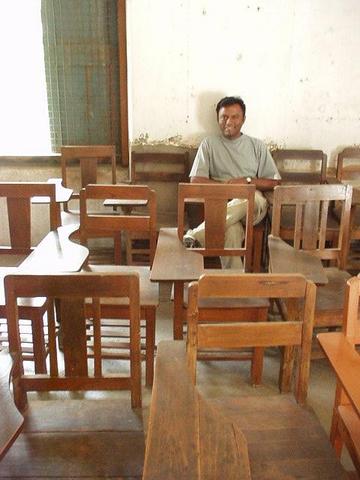 This is where Hari Tammana and Venu Valmeekam first took a course in Genetics. The outside of the building was remarkably ramshackle; it was more of a large-scale shack than what one would normally call a "building". It's a long ways between here and Affymetrix, one of the best biotech companies in America, where I worked with Hari and Venu.
This is where Hari Tammana and Venu Valmeekam first took a course in Genetics. The outside of the building was remarkably ramshackle; it was more of a large-scale shack than what one would normally call a "building". It's a long ways between here and Affymetrix, one of the best biotech companies in America, where I worked with Hari and Venu. |
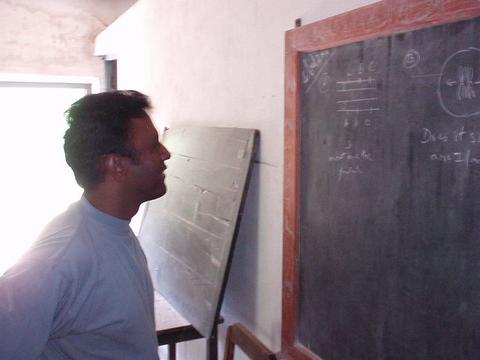 Hari studies the genetics lesson of the day, left on the blackboard. It was something to do with crossover.
Hari studies the genetics lesson of the day, left on the blackboard. It was something to do with crossover. |
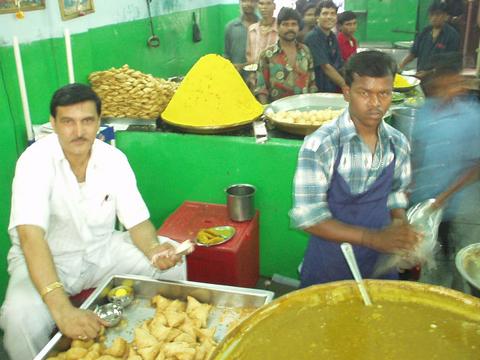 Gokul Chaat is the premier chaat (greasy Indian snack food) house, where Hari had spent many a rupee in his youth. It has since grown in magnitude and now occupies a four story tower, each with a kitchen serving chaat. Those triangular things near his hand are samosas; the big vat is cholle, curried chickpeas; a swastika, which is a symbol of Hinduism, is barely discernable on the yellow pile of... stuff... to the owner's right. At first he didn't want to have his picture taken: "What would you want my picture for?" he asked me in Telugu. Hari interceded on my behalf, and the owner relented.
Gokul Chaat is the premier chaat (greasy Indian snack food) house, where Hari had spent many a rupee in his youth. It has since grown in magnitude and now occupies a four story tower, each with a kitchen serving chaat. Those triangular things near his hand are samosas; the big vat is cholle, curried chickpeas; a swastika, which is a symbol of Hinduism, is barely discernable on the yellow pile of... stuff... to the owner's right. At first he didn't want to have his picture taken: "What would you want my picture for?" he asked me in Telugu. Hari interceded on my behalf, and the owner relented. |
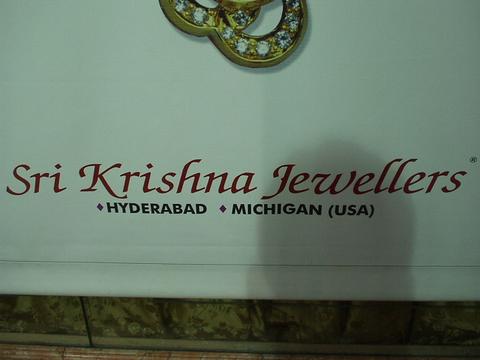 If there are any Michiganders who notice a "Sri Krishna Jewellers" in their neighborhood, tell them that the home office seems to be doing just fine.
If there are any Michiganders who notice a "Sri Krishna Jewellers" in their neighborhood, tell them that the home office seems to be doing just fine. |
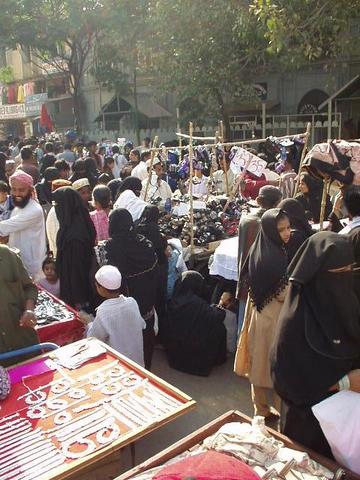 I already felt very conspicuous here, since I was the six-foot white guy among a packed shopping crowd consisting primarily of short, burkha-clad Muslim women doing a little late holiday shopping, so I only took this one quick overhead picture. The crowd density and magnitude was similar to San Francisco's Halloween, or Washington D.C.'s Fourth of July, but the participants made it a bizarre experience.
I already felt very conspicuous here, since I was the six-foot white guy among a packed shopping crowd consisting primarily of short, burkha-clad Muslim women doing a little late holiday shopping, so I only took this one quick overhead picture. The crowd density and magnitude was similar to San Francisco's Halloween, or Washington D.C.'s Fourth of July, but the participants made it a bizarre experience. |
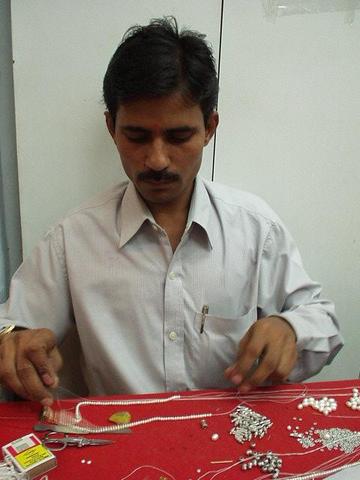 As I was walking around Charminar, Hari and Preethi were shopping for pearls. The shop had example designs to choose from, and then customers could indicate design changes that they would like. This man would then take pearls from a tackle box filled with different sizes and grades of pearls and string up the custom piece. He was no novice -- he spliced and threaded with a deterity that must have been born of years of practice.
As I was walking around Charminar, Hari and Preethi were shopping for pearls. The shop had example designs to choose from, and then customers could indicate design changes that they would like. This man would then take pearls from a tackle box filled with different sizes and grades of pearls and string up the custom piece. He was no novice -- he spliced and threaded with a deterity that must have been born of years of practice. |
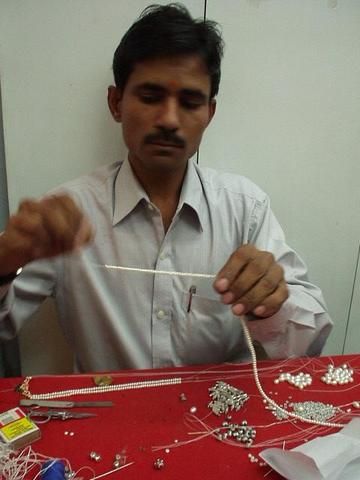 More pearl-stringing.
More pearl-stringing. |
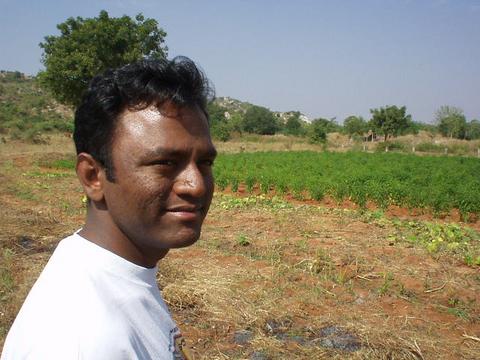 We visited seven acres of farmland that Hari's father and brother had purchased and developed. It has since become evident that there isn't enough water and that it's difficult to maintain, so they are trying to sell it. Whereas I manage my investments by reading up on what mutual funds to invest in, Hari's father would have to manage his farm -- going out and making sure that things were properly planted, harvested, and sold. This is representative of life in India, in that if you have any kind of money at all, you are frequently managing a small horde of people: tailors, drivers, housekeepers, and farmers, for starters. Each of these needs to be encouraged and prodded, as I experienced in trying to get the tailor across the street to make a copy of the pants I had made at Madurai.
We visited seven acres of farmland that Hari's father and brother had purchased and developed. It has since become evident that there isn't enough water and that it's difficult to maintain, so they are trying to sell it. Whereas I manage my investments by reading up on what mutual funds to invest in, Hari's father would have to manage his farm -- going out and making sure that things were properly planted, harvested, and sold. This is representative of life in India, in that if you have any kind of money at all, you are frequently managing a small horde of people: tailors, drivers, housekeepers, and farmers, for starters. Each of these needs to be encouraged and prodded, as I experienced in trying to get the tailor across the street to make a copy of the pants I had made at Madurai. |
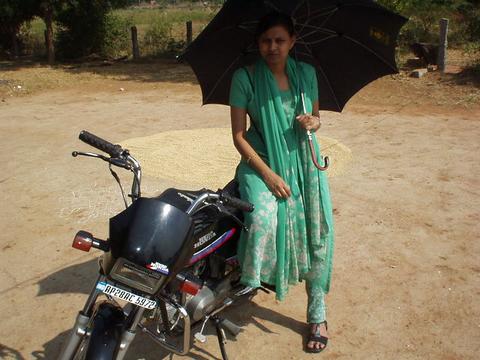 Preethi reclining against the motorcycle of a family friend who owns a nearby farm, Ashok Reddy.
Preethi reclining against the motorcycle of a family friend who owns a nearby farm, Ashok Reddy. |
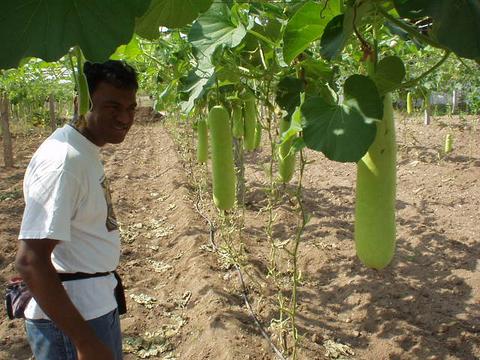 Hari with zucchini-like vegetables hanging from trellises; these are at Ashok Reddy's place.
Hari with zucchini-like vegetables hanging from trellises; these are at Ashok Reddy's place. |
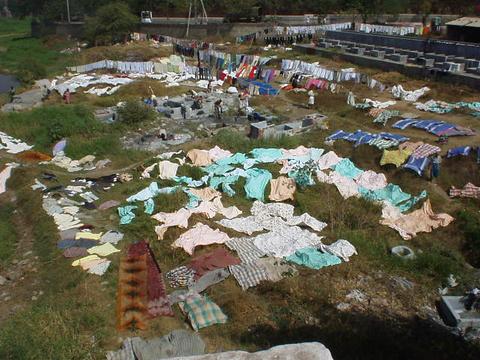 This isn't colorful litter, it's a dhobi-ghat, or "washing-step" area where dhobi-wallas, clothes washers, beat the living hell out of people's laundry. It's rather convenient that you can get just a few items washed at each hotel by a dhobi-walla service, since I'm only carrying a few items of clothing.
This isn't colorful litter, it's a dhobi-ghat, or "washing-step" area where dhobi-wallas, clothes washers, beat the living hell out of people's laundry. It's rather convenient that you can get just a few items washed at each hotel by a dhobi-walla service, since I'm only carrying a few items of clothing. |
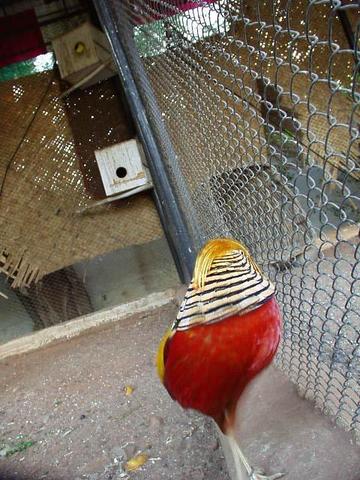 This is a colorful bird in the "bird park" of Hyderabad Public Gardens.
This is a colorful bird in the "bird park" of Hyderabad Public Gardens. |
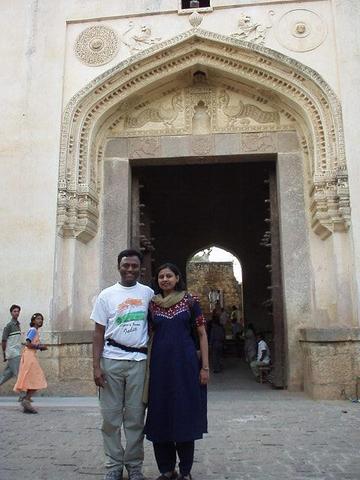 Hari and Preethi at the main gate of Golconda fort, which saw it's heyday under the Qutb Shah kings in the 16th and 17th century until it was conquered by the last of the great Moghul emperors, Aurangzeb, in 1687. Aurangzeb, the third son of then-emperor Shah Jehan, had been sent to campaign in the Deccan because his father didn't trust him. This mistrust was well placed, since Aurangzeb imprisoned his father in 1658 when the latter fell ill. Within the year Aurangzeb defeated the armies of his elder brother Dara, who had been the son favored for the throne, and then sent Dara's head to his father in prison. In large part due to the harhness of his rule, the Moghul empire more or less disintegrated after his rule, leaving a power vacuum that the East India Company stepped into.
Hari and Preethi at the main gate of Golconda fort, which saw it's heyday under the Qutb Shah kings in the 16th and 17th century until it was conquered by the last of the great Moghul emperors, Aurangzeb, in 1687. Aurangzeb, the third son of then-emperor Shah Jehan, had been sent to campaign in the Deccan because his father didn't trust him. This mistrust was well placed, since Aurangzeb imprisoned his father in 1658 when the latter fell ill. Within the year Aurangzeb defeated the armies of his elder brother Dara, who had been the son favored for the throne, and then sent Dara's head to his father in prison. In large part due to the harhness of his rule, the Moghul empire more or less disintegrated after his rule, leaving a power vacuum that the East India Company stepped into. |
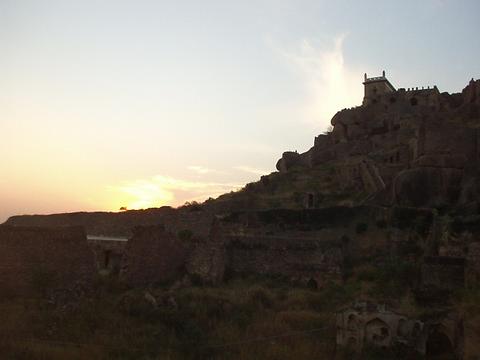 The structure high on the hill, the Bala Hissar, is supposedly where Aurangzeb's emissary, as Aurangzeb's men took control of the fort, met Abul Hasan, the last of the Qutub Shahi kings. Abul Hasan invited the emissary to sit for breakfast with him. When the emissary pointed out that this was a very calm reaction for one who had just lost his kingdom, Abul Hasan told him that "It was Allah who gave this kingdom to us, and it is he who wills that it be taken from us."
The structure high on the hill, the Bala Hissar, is supposedly where Aurangzeb's emissary, as Aurangzeb's men took control of the fort, met Abul Hasan, the last of the Qutub Shahi kings. Abul Hasan invited the emissary to sit for breakfast with him. When the emissary pointed out that this was a very calm reaction for one who had just lost his kingdom, Abul Hasan told him that "It was Allah who gave this kingdom to us, and it is he who wills that it be taken from us."
|
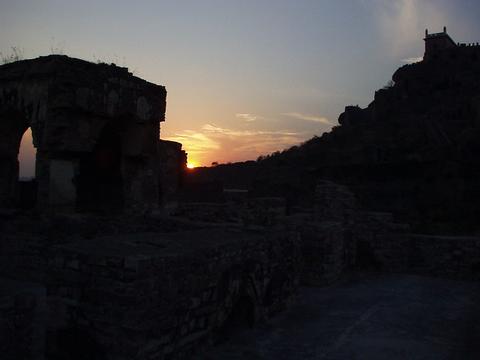 Sunset on Golconda fort.
Sunset on Golconda fort. |
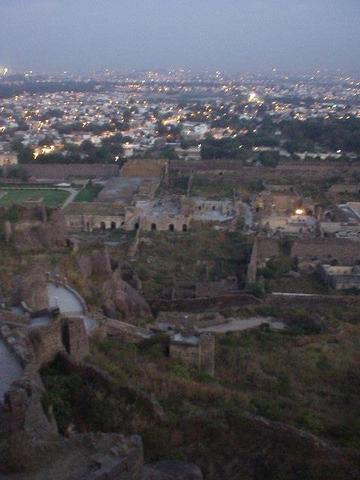 The city of Hyderabad as seen from Golconda Fort.
The city of Hyderabad as seen from Golconda Fort. |
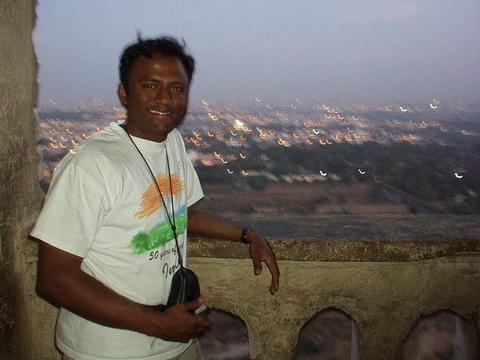 Hari at the peak of Golconda, with his home city of Hyderabad behind him.
Hari at the peak of Golconda, with his home city of Hyderabad behind him. |
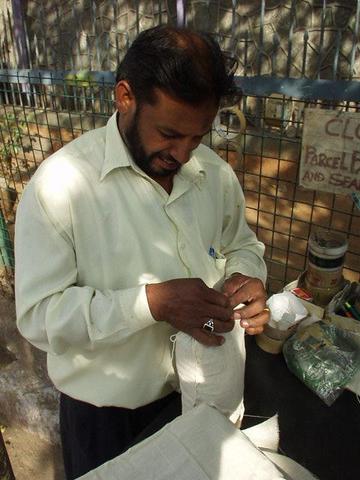 When you send a package in India, you sew it up in heavy linen first. There are usually several stands of men who are doing this just outside of the post office. After it's sewn up, they seal it with red wax and you write the address on the linen. I figured that like the hyperbolic "Super Express" busses, the "Speed Post" would take a while, but it wasn't so: a package I sent from Hyderabad reached Michigan City in six days. Yowsa.
When you send a package in India, you sew it up in heavy linen first. There are usually several stands of men who are doing this just outside of the post office. After it's sewn up, they seal it with red wax and you write the address on the linen. I figured that like the hyperbolic "Super Express" busses, the "Speed Post" would take a while, but it wasn't so: a package I sent from Hyderabad reached Michigan City in six days. Yowsa. |
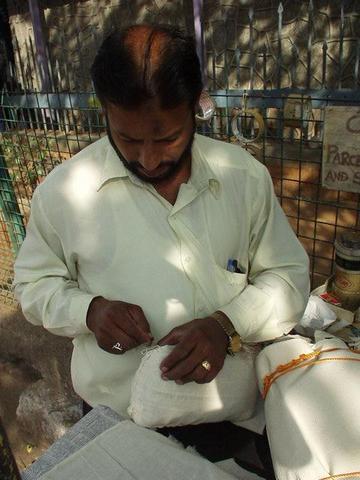
|
 [NOTE: This picture is missing due to technical difficulties; I hope to put it back in soon] The day before Hari and I were leaving, each for our own destination (he for Gulbarga, home of the in-laws, and me for Hampi, home of the Vijayanagar empire) Hari took me and all of his Hyderabadi friends out for dinner. Prabodh is the one just to my right, and you can see Rajanikanth's (which, understandably, is frequently shortened to "Raj") right eye peeking out there. The near woman was the wife of a friend, and she didn't speak English; the farther woman I didn't really talk to. In any event, I don't remember their names.
[NOTE: This picture is missing due to technical difficulties; I hope to put it back in soon] The day before Hari and I were leaving, each for our own destination (he for Gulbarga, home of the in-laws, and me for Hampi, home of the Vijayanagar empire) Hari took me and all of his Hyderabadi friends out for dinner. Prabodh is the one just to my right, and you can see Rajanikanth's (which, understandably, is frequently shortened to "Raj") right eye peeking out there. The near woman was the wife of a friend, and she didn't speak English; the farther woman I didn't really talk to. In any event, I don't remember their names. |
 This is where Hari Tammana and Venu Valmeekam first took a course in Genetics. The outside of the building was remarkably ramshackle; it was more of a large-scale shack than what one would normally call a "building". It's a long ways between here and Affymetrix, one of the best biotech companies in America, where I worked with Hari and Venu.
This is where Hari Tammana and Venu Valmeekam first took a course in Genetics. The outside of the building was remarkably ramshackle; it was more of a large-scale shack than what one would normally call a "building". It's a long ways between here and Affymetrix, one of the best biotech companies in America, where I worked with Hari and Venu. Hari studies the genetics lesson of the day, left on the blackboard. It was something to do with crossover.
Hari studies the genetics lesson of the day, left on the blackboard. It was something to do with crossover. Gokul Chaat is the premier chaat (greasy Indian snack food) house, where Hari had spent many a rupee in his youth. It has since grown in magnitude and now occupies a four story tower, each with a kitchen serving chaat. Those triangular things near his hand are samosas; the big vat is cholle, curried chickpeas; a swastika, which is a symbol of Hinduism, is barely discernable on the yellow pile of... stuff... to the owner's right. At first he didn't want to have his picture taken: "What would you want my picture for?" he asked me in Telugu. Hari interceded on my behalf, and the owner relented.
Gokul Chaat is the premier chaat (greasy Indian snack food) house, where Hari had spent many a rupee in his youth. It has since grown in magnitude and now occupies a four story tower, each with a kitchen serving chaat. Those triangular things near his hand are samosas; the big vat is cholle, curried chickpeas; a swastika, which is a symbol of Hinduism, is barely discernable on the yellow pile of... stuff... to the owner's right. At first he didn't want to have his picture taken: "What would you want my picture for?" he asked me in Telugu. Hari interceded on my behalf, and the owner relented. If there are any Michiganders who notice a "Sri Krishna Jewellers" in their neighborhood, tell them that the home office seems to be doing just fine.
If there are any Michiganders who notice a "Sri Krishna Jewellers" in their neighborhood, tell them that the home office seems to be doing just fine. I already felt very conspicuous here, since I was the six-foot white guy among a packed shopping crowd consisting primarily of short, burkha-clad Muslim women doing a little late holiday shopping, so I only took this one quick overhead picture. The crowd density and magnitude was similar to San Francisco's Halloween, or Washington D.C.'s Fourth of July, but the participants made it a bizarre experience.
I already felt very conspicuous here, since I was the six-foot white guy among a packed shopping crowd consisting primarily of short, burkha-clad Muslim women doing a little late holiday shopping, so I only took this one quick overhead picture. The crowd density and magnitude was similar to San Francisco's Halloween, or Washington D.C.'s Fourth of July, but the participants made it a bizarre experience. As I was walking around Charminar, Hari and Preethi were shopping for pearls. The shop had example designs to choose from, and then customers could indicate design changes that they would like. This man would then take pearls from a tackle box filled with different sizes and grades of pearls and string up the custom piece. He was no novice -- he spliced and threaded with a deterity that must have been born of years of practice.
As I was walking around Charminar, Hari and Preethi were shopping for pearls. The shop had example designs to choose from, and then customers could indicate design changes that they would like. This man would then take pearls from a tackle box filled with different sizes and grades of pearls and string up the custom piece. He was no novice -- he spliced and threaded with a deterity that must have been born of years of practice. More pearl-stringing.
More pearl-stringing. We visited seven acres of farmland that Hari's father and brother had purchased and developed. It has since become evident that there isn't enough water and that it's difficult to maintain, so they are trying to sell it. Whereas I manage my investments by reading up on what mutual funds to invest in, Hari's father would have to manage his farm -- going out and making sure that things were properly planted, harvested, and sold. This is representative of life in India, in that if you have any kind of money at all, you are frequently managing a small horde of people: tailors, drivers, housekeepers, and farmers, for starters. Each of these needs to be encouraged and prodded, as I experienced in trying to get the tailor across the street to make a copy of the pants I had made at Madurai.
We visited seven acres of farmland that Hari's father and brother had purchased and developed. It has since become evident that there isn't enough water and that it's difficult to maintain, so they are trying to sell it. Whereas I manage my investments by reading up on what mutual funds to invest in, Hari's father would have to manage his farm -- going out and making sure that things were properly planted, harvested, and sold. This is representative of life in India, in that if you have any kind of money at all, you are frequently managing a small horde of people: tailors, drivers, housekeepers, and farmers, for starters. Each of these needs to be encouraged and prodded, as I experienced in trying to get the tailor across the street to make a copy of the pants I had made at Madurai. Preethi reclining against the motorcycle of a family friend who owns a nearby farm, Ashok Reddy.
Preethi reclining against the motorcycle of a family friend who owns a nearby farm, Ashok Reddy. Hari with zucchini-like vegetables hanging from trellises; these are at Ashok Reddy's place.
Hari with zucchini-like vegetables hanging from trellises; these are at Ashok Reddy's place. This isn't colorful litter, it's a dhobi-ghat, or "washing-step" area where dhobi-wallas, clothes washers, beat the living hell out of people's laundry. It's rather convenient that you can get just a few items washed at each hotel by a dhobi-walla service, since I'm only carrying a few items of clothing.
This isn't colorful litter, it's a dhobi-ghat, or "washing-step" area where dhobi-wallas, clothes washers, beat the living hell out of people's laundry. It's rather convenient that you can get just a few items washed at each hotel by a dhobi-walla service, since I'm only carrying a few items of clothing. This is a colorful bird in the "bird park" of Hyderabad Public Gardens.
This is a colorful bird in the "bird park" of Hyderabad Public Gardens. Hari and Preethi at the main gate of Golconda fort, which saw it's heyday under the Qutb Shah kings in the 16th and 17th century until it was conquered by the last of the great Moghul emperors, Aurangzeb, in 1687. Aurangzeb, the third son of then-emperor Shah Jehan, had been sent to campaign in the Deccan because his father didn't trust him. This mistrust was well placed, since Aurangzeb imprisoned his father in 1658 when the latter fell ill. Within the year Aurangzeb defeated the armies of his elder brother Dara, who had been the son favored for the throne, and then sent Dara's head to his father in prison. In large part due to the harhness of his rule, the Moghul empire more or less disintegrated after his rule, leaving a power vacuum that the East India Company stepped into.
Hari and Preethi at the main gate of Golconda fort, which saw it's heyday under the Qutb Shah kings in the 16th and 17th century until it was conquered by the last of the great Moghul emperors, Aurangzeb, in 1687. Aurangzeb, the third son of then-emperor Shah Jehan, had been sent to campaign in the Deccan because his father didn't trust him. This mistrust was well placed, since Aurangzeb imprisoned his father in 1658 when the latter fell ill. Within the year Aurangzeb defeated the armies of his elder brother Dara, who had been the son favored for the throne, and then sent Dara's head to his father in prison. In large part due to the harhness of his rule, the Moghul empire more or less disintegrated after his rule, leaving a power vacuum that the East India Company stepped into. The structure high on the hill, the Bala Hissar, is supposedly where Aurangzeb's emissary, as Aurangzeb's men took control of the fort, met Abul Hasan, the last of the Qutub Shahi kings. Abul Hasan invited the emissary to sit for breakfast with him. When the emissary pointed out that this was a very calm reaction for one who had just lost his kingdom, Abul Hasan told him that "It was Allah who gave this kingdom to us, and it is he who wills that it be taken from us."
The structure high on the hill, the Bala Hissar, is supposedly where Aurangzeb's emissary, as Aurangzeb's men took control of the fort, met Abul Hasan, the last of the Qutub Shahi kings. Abul Hasan invited the emissary to sit for breakfast with him. When the emissary pointed out that this was a very calm reaction for one who had just lost his kingdom, Abul Hasan told him that "It was Allah who gave this kingdom to us, and it is he who wills that it be taken from us."
 Sunset on Golconda fort.
Sunset on Golconda fort. The city of Hyderabad as seen from Golconda Fort.
The city of Hyderabad as seen from Golconda Fort. Hari at the peak of Golconda, with his home city of Hyderabad behind him.
Hari at the peak of Golconda, with his home city of Hyderabad behind him. When you send a package in India, you sew it up in heavy linen first. There are usually several stands of men who are doing this just outside of the post office. After it's sewn up, they seal it with red wax and you write the address on the linen. I figured that like the hyperbolic "Super Express" busses, the "Speed Post" would take a while, but it wasn't so: a package I sent from Hyderabad reached Michigan City in six days. Yowsa.
When you send a package in India, you sew it up in heavy linen first. There are usually several stands of men who are doing this just outside of the post office. After it's sewn up, they seal it with red wax and you write the address on the linen. I figured that like the hyperbolic "Super Express" busses, the "Speed Post" would take a while, but it wasn't so: a package I sent from Hyderabad reached Michigan City in six days. Yowsa.
